Don’t we all have the actual brand in mind when we hear slogans like “Just do it”, “I’m lovin’ it”, or “You’re not you when you’re hungry”? (Nike, McDonald’s, and Snickers respectively)
You could definitely say that your marketing campaign has nailed it when people start using catchphrases from your ad in everyday life.
But, getting to that kind of success isn’t a walk in the park.
Above all, marketing campaigns are demanding — you need a strong management strategy and steady nerves to navigate trends, consumer behavior, and different media options.
However, with the right marketing project management tool and guide, running campaigns becomes far less complicated.
Have a look at our 7-step guide and use it to launch your next marketing campaign with confidence!

In this article:
What is marketing campaign management?
Marketing campaign management is the process of organizing marketing activities to achieve a specific goal, usually to engage with existing customers or acquire new ones.
All the marketing activities, from planning to launching a campaign, often share the same idea or theme, as the campaign goal is to create a consistent marketing message.
You may view the marketing campaign as telling a unique story intended to resonate with a specific target audience. Any successful marketing campaign is based on a profound understanding of the interests of your audience.
Meanwhile, campaign management is the people and processes behind that story. It applies to all team members, stakeholders, and strategic activities involved in the planning, execution, monitoring, and evaluation phases of the campaign.
What does a marketing campaign manager do?
As a marketing manager, it’s your job to make sure that the campaign runs smoothly throughout all campaign phases — from initiation to post-implementation review.
Here’s an overview of what marketing managers do:
- Gather their marketing team, establish cooperation with other departments, and connect key stakeholders.
- Brainstorm ideas, define goals and objectives, set deadlines, and manage resources.
- Delegate tasks, provide feedback, and take part in preparing ads and social media posts.
- Track key metrics and report results on the effectiveness of the campaign.

A 7-step guide to nailing marketing campaign management
The marketing campaign management process is a large-scale undertaking. To help you with your next campaign, we’ve broken the process down into 7 key steps you should follow.
#1 Set a clear goal
A good marketing campaign must have a clear purpose. Knowing exactly what you want to achieve will pave the way for a successful campaign.
Before you define your goals, take the following factors into account:
- The data you’ve collected from past campaigns,
- The stakeholders’ input,
- Major competitors’ marketing activities, and
- The company’s business priorities.
Once you sift through all these factors, you can define your goals more precisely. Do this by using the S.M.A.R.T. goals criteria:
- Specific,
- Measurable,
- Attainable,
- Relevant, and
- Time-based.
By applying these criteria, you get a clear direction on how to define your goals.
For instance, do you want to increase web traffic? That goal is not precise enough. So, be specific — e.g., try to increase your website traffic by 30% in the next 3 months.
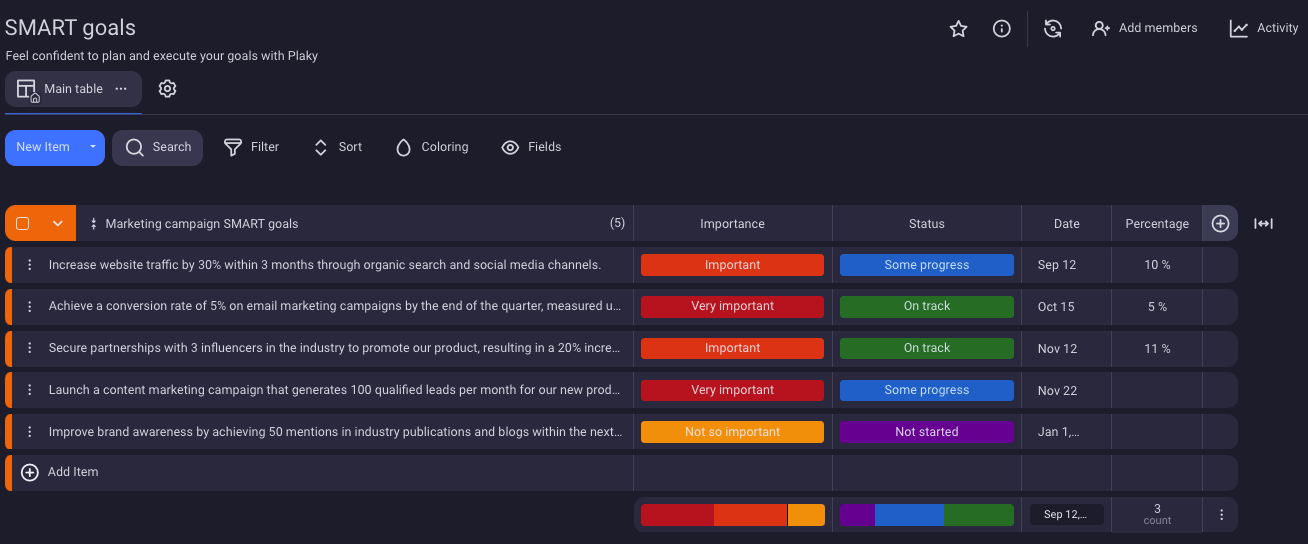
#2 Identify your target audience
Each effective marketing campaign turned out that way because it resonated well with its target audience. And as a marketer, it’s your responsibility to analyze the target audience and understand their pain points and interests.
To avoid wasting money, time, and effort on a failed campaign, detailed audience segmentation is key. You can perform it by gathering basic information about your audience, such as:
- Age,
- Gender,
- Race,
- Location,
- Marital status,
- Occupation,
- Income level, and
- Education.
Market research is done best when you include practices like surveys, interviews, and social listening. After you define your target audience’s biggest problems and desires in relation to your product or service, you’ll know what messages to communicate.
It’s also a good idea to explore what platforms they use the most and the type of content they consume. When you understand the kind of lifestyle they lead, you’ll find a way to influence their purchasing behavior and their decision-making process.
#3 Specify metrics for measuring success
You can hardly know if your campaign brings results if you don’t include analytics and metrics to assess whether you are meeting your goals.
The moment your campaign comes to the fore, your focus should be on relevant key performance indicators (KPIs), such as:
- Click-through rate (CTR) — Refers to the number of clicks your ads or pages get compared to the number of times they are shown to people.
- Organic traffic — Shows the number of people visiting your website via unpaid sources, i.e., free/organic traffic.
- Backlinks — Refers to the situations when one website links its article to another source or website.
- Impressions — Used to count the number of times an ad, digital content, or social media post was displayed.
- Unique page visitors — Indicates the actual number of visitors to your website by counting each visitor only once.
- Conversion rate — Used to track the number of users who took a desired action, such as making a purchase, “converting” to paid users, filling out a contact form, etc.
- Bounce rate — Shows the number of users leaving your website after they see only one page.
- Qualified leads — Refers to the number of visitors recognized as being highly interested in buying your product(s) or moving from a free trial user to a paying user.
Track campaign metrics in Plaky
Keep an eye on relevant metrics so that you can make the necessary adjustments to campaign activities on time.
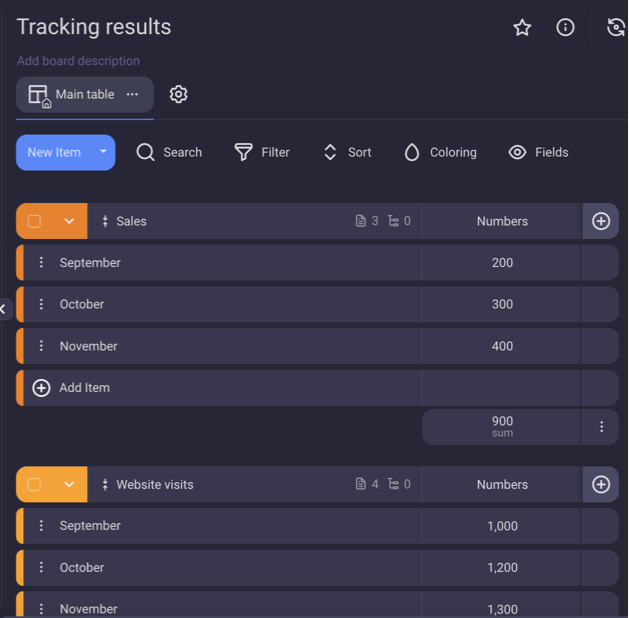
💡Plaky Pro Tip
Key performance indicators are crucial performance metrics used in different business areas. If you want to find out more about project KPIs, have a look at the following article:
#4 Define resources and budget
When identifying campaign resources, there are several things to consider — like people, things, and money.
A good starting point would be to use historical data — data from previous paid campaigns — as it can give you a considerable insight into the resource requirements for your new campaign.
Alternatively, try to list all campaign deliverables (e.g., publications, news articles, social media posts) along with the resources you’ll need for each one (e.g., contractors, content creators, funds for influencers).
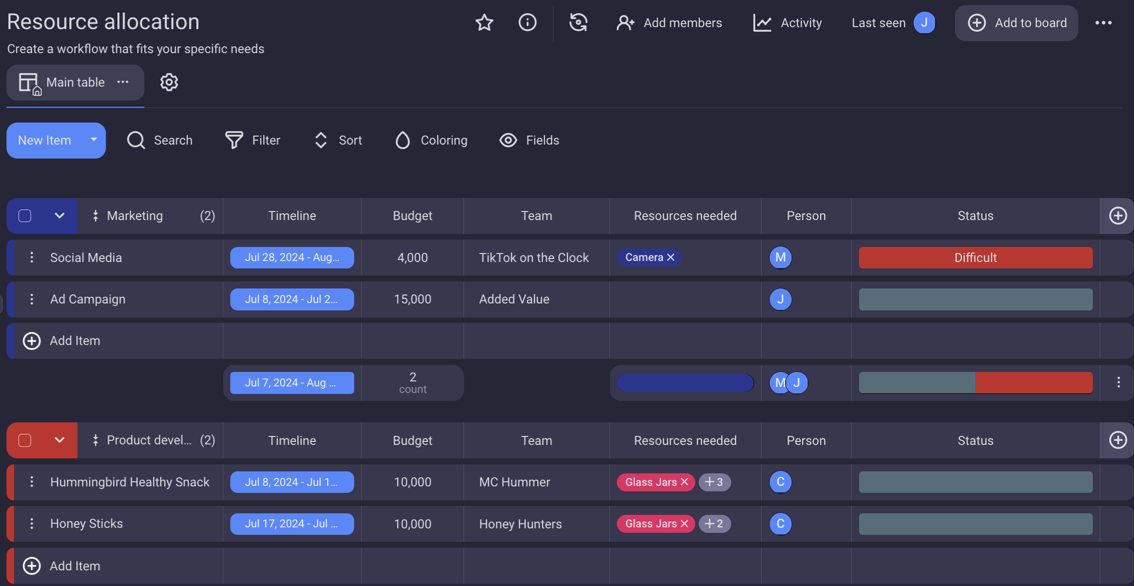
Once you have all the resources on your list, it’s time to prepare a proper budget plan. To do this, you can use some of the common project budgeting methods or track all budget-related information within a project management tool.
Relying on software is the most convenient choice — you can use common budgeting features to list costs transparently and categorize specific budget expenses.
Then, when you have your budget plan and resources allocated, make sure you send them to your stakeholders and relevant departments for their go-ahead.

Plan your campaign budget in Plaky
#5 Pick marketing campaign channels
Knowing your audience will help you decide what channels to use. After all, if your target audience doesn’t use emails, there’s no point in running an email marketing campaign, right?
Bear in mind that you can use different marketing channels to reach different target audiences depending on where they are in your marketing funnel.
For instance, high-quality SEO content can raise your brand awareness whereas webinars or case studies are ideal for educating customers who are in the consideration phase of the funnel.
The audience segmentation you conducted earlier is pure gold in this case. It can help you choose between digital platforms and traditional advertising channels.
You can, as well, opt for a multichannel campaign and find an ideal mix of paid and organic channels.
Some of the most popular digital platforms among younger consumers include:
- Instagram,
- YouTube,
- TikTok, and
- X.
These platforms have fueled the rise of a new, especially popular marketing trend — influencer marketing — where companies collaborate with influencers who have their armies of followers.
Other options include channels such as LinkedIn, email, and SEO-optimized content (blogs, ebooks, microsites). As a matter of fact, 87% of B2B marketers reported that content marketing helped them raise brand awareness.
For more traditional marketing, there are TV and radio ads as well as cold call campaigns, which tend to appeal more to older audiences.

#6 Create marketing campaign content
Yes, we’ve finally reached the most important step in marketing campaign governance. You are ready to gather a team and spend some time brainstorming and exploring the best channels and mediums that will touch your target audience.
Now, a good rule of thumb is to make the content personalized, engaging, and relevant to your customers. This means — speak the language of your audience.
As for the organization part, try to publish content regularly and nourish a consistent and recognizable brand voice and visual identity.
To achieve consistency, you can create a content plan using an all-purpose project management tool. This way, you’ll make sure no deadline is missed and stay informed about:
- Where you’re at with each specific platform,
- What’s been published and when, and
- Who’s responsible for each task.
You can organize your entire campaign management process flow by setting up a separate content board within a chosen tool.
That said, to save time on starting the board from scratch, have a go with a content calendar template.
Get our content calendar template
The benefit of using a premade template is that it gives you the foundation for your content calendar, and helps you get started with overall content organization. Of course, you can customize each part of the template according to your needs.
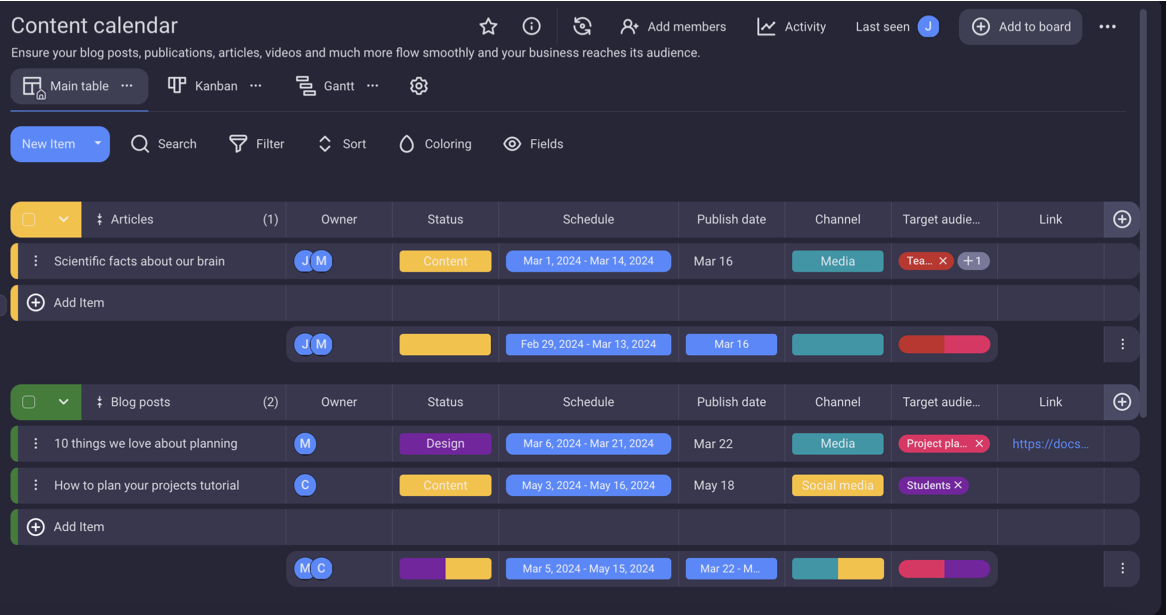
Another option is to organize content by platform and create a separate group for each of the marketing channels. This approach makes content organization straightforward and easier to manage. You’ll quickly locate channel-related tasks, saving valuable time and streamlining communication within the content team.
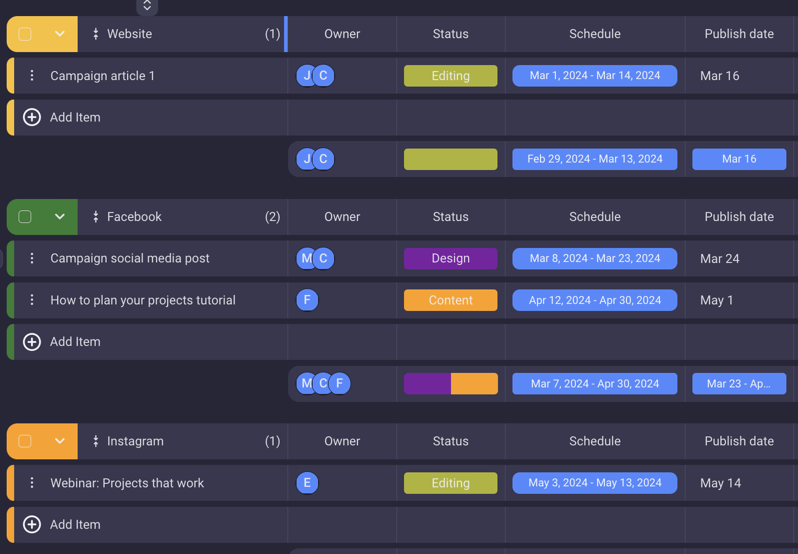
💡 Plaky Pro Tip
No ideas? No problem! If you ever run out of ideas for your social media content calendar, remember to check out an extensive list of great ideas in this guide:
#7 Monitor the campaign workflow and analyze the results
As soon as your marketing campaign is active, you can start monitoring every single detail. From tracking key metrics and collecting data to adjusting tactics as needed, it’s all in the manager’s hands.
Experienced marketing managers know how to save themselves a lot of time and headaches while tracking project performance — they use reliable marketing PM software for organized task management.
By taking advantage of key progress-tracking functions, such as statuses and timelines, you can keep an eye on your entire workflow — and any potential bottlenecks.
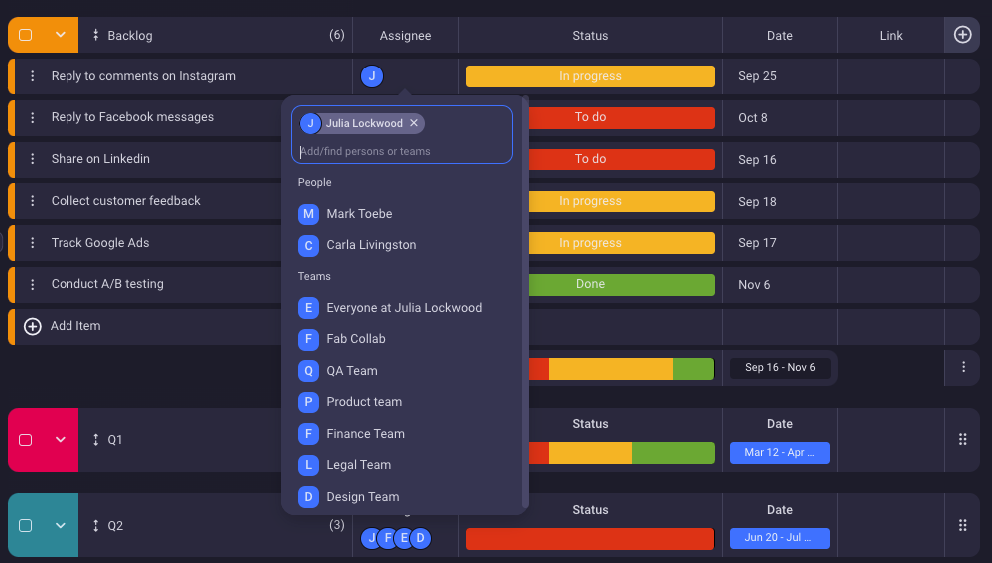
Track campaign progress in Plaky
When it comes to analyzing the results, ask yourself the following:
- Are the results something you’ve expected?
- Do they align with what you’ve intended to achieve in the initiation project phase?
- What can you do now to make the results better?
- What conclusions can you draw for the next time?
Make sure to dive deeper into the specific data, e.g., how many website visits you’ve gotten compared to the period before the campaign, or how many products you’ve sold in the campaign month.
Also, remember to keep track of the summary of the important data throughout the campaign. Using specific software for this purpose will simplify gathering data in real time. A feature, such as Plaky’s summary row, which summarizes all this data within the table itself, could also prove handy, letting you instantly see just how close you are to your original goals.
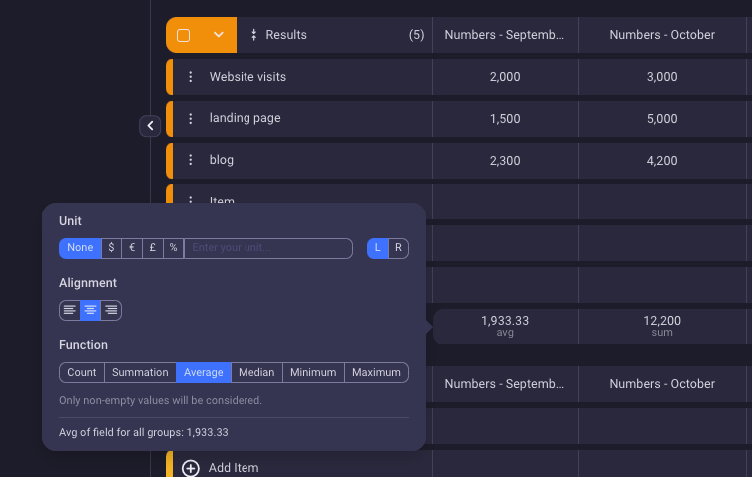
💡Plaky Pro Tip
Keep tabs on all the activities taking place throughout your marketing campaigns with our daily marketing report template. Check it out in the post below:
Why is marketing campaign management important?
It’s true that an effective marketing campaign management process is not a cast-iron guarantee of campaign success. However, it can definitely contribute to better work organization and greatly impact a desired outcome.
Essentially, having a sound management strategy for your marketing campaign is important because it helps you:
- Enhance cross-departmental cooperation,
- Facilitate communication among different teams and stakeholders,
- Streamline activities,
- Reduce stress,
- Have a clear overview of tasks, deadlines, and expenditures,
- Spot bottlenecks and address them in a timely manner, and
- Maintain consistency in the messages your brand sends.
Better yet, being mindful of your approach to marketing management will help you unlock the benefits of well-organized campaigns, such as:
- Increased sales of the marketed product or service,
- Rising profit for your company,
- Lead generation,
- Growth in new markets,
- Increased product awareness, and
- Stronger brand image.

Common types of marketing campaigns
The most common marketing campaign types include:
- Broadcast marketing — recognized as a traditional marketing form for promotion (e.g., TV and radio),
- Email marketing — used as a form of direct marketing, allowing the creation of personalized content usually based on purchase history,
- Social media campaign marketing — considered to be a modern type of marketing and used to raise brand awareness, reach wide audiences, and boost engagement (e.g., social media posts on popular platforms, paid ads, infographics, gifs, etc.).
- Content marketing — represents informative content that answers questions and offers practical tips (e.g., ebooks, articles, webinars, podcasts, etc.),
- Product marketing — used to raise product/service awareness and highlight its benefits (e.g., product videos, product blog content, demos, customer stories),
- Search engine marketing — focused on promoting products/services through search engines (e.g., PPC ads, SEO articles, and landing pages),
- Influencer marketing — based on endorsements and product/service mentions given by popular influencers and mostly used to increase brand awareness and conversions (e.g., sponsored posts, product reviews, etc.), and
- Video marketing — refers to the use of video content to promote a brand, product, or service.
Depending on what they aim to achieve, marketing campaigns can also be:
- Brand awareness campaigns,
- Rebranding campaigns,
- Brand launch campaigns,
- Product launch campaigns,
- Increased sales and profit campaigns, and
- Customer retention campaigns.
With a whole range of marketing campaign types, it can be tricky to choose the right one(s).
However, bear in mind that the channel you opt for mainly depends on your target audience’s preferences and the marketing goals you’ve set for your campaign.
Elevate your marketing campaign process with Plaky
The biggest challenge marketers face when running campaigns is how to organize every little detail of the campaign process. That said, it’s not uncommon for them to struggle with project time management and budget organization too.
Luckily, these are all matters that can be easily resolved with effective marketing project management software like Plaky.
Plaky can simplify the entire process by helping you to:
- Stay organized,
- Save your time, and
- Manage your costs.
Let’s see what makes Plaky your #1 choice.
Stay organized
In Plaky, staying organized even throughout complex marketing campaigns is entirely possible.
You can dedicate an item to each task and organize them into sections. By adding custom fields to each item, e.g., status or date, you can add more structure to your data and make sure no information falls through the cracks.
Within each item, you can add other details too, such as links or files, to keep all task-related data in one place.
Better yet, you can tag the team members or departments responsible for each task to increase accountability and ensure everyone knows what they should be doing.
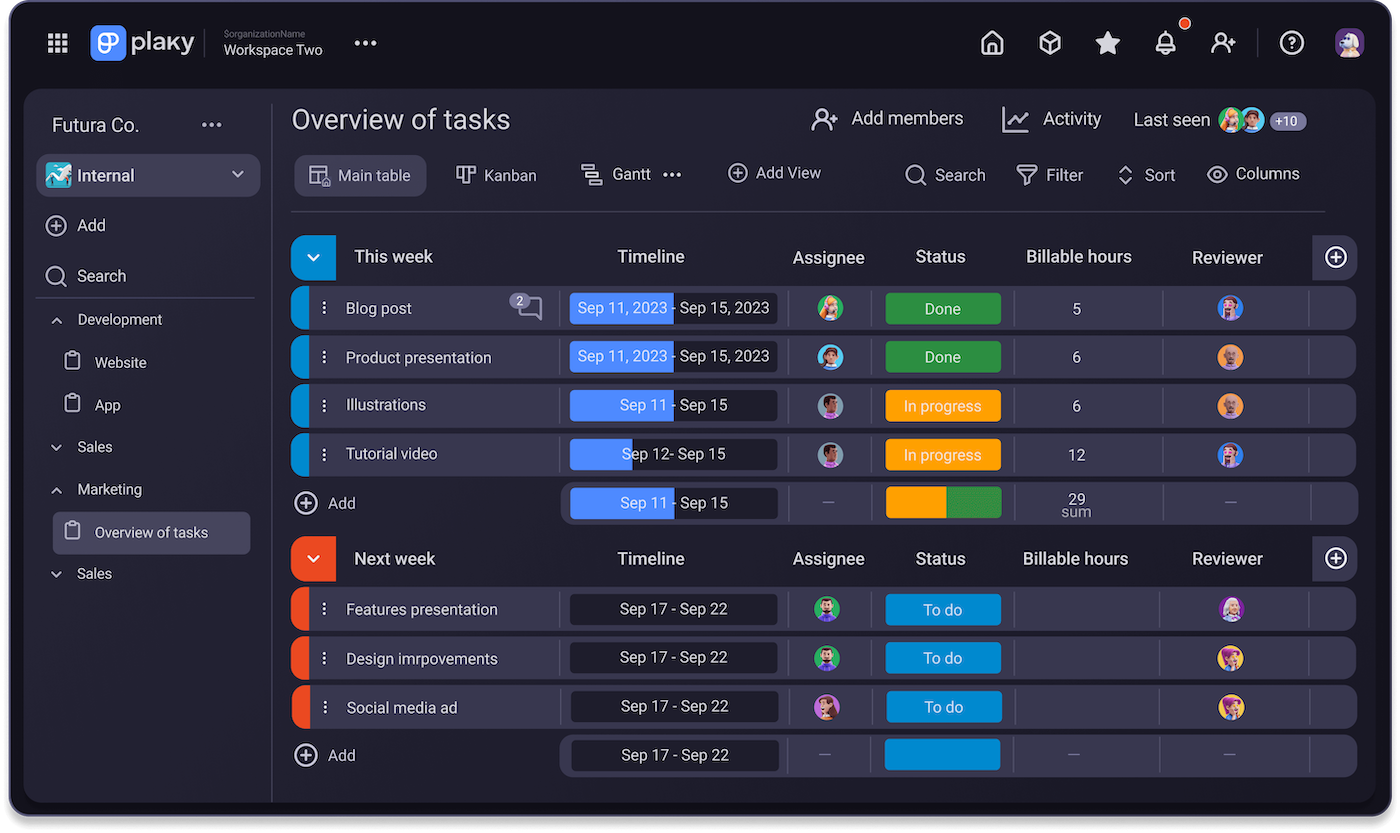
With Plaky, you can even track the progress of your tasks and see where each stands within 3 different views — Table, Kanban, and Gantt view.
Plus, you can easily keep track of all board changes in the activity log — a real-time record of all project activities. And if you need specific information about a task, just use the sort or filter option to get to it more quickly.
Save your time
You can use Plaky to create your whole marketing strategy plan and break it into manageable phases.
To kick things off and save time, rely on Plaky’s marketing strategy template — use it as the foundation — or inspiration — for your strategy.
Get our marketing strategy template
The template will help you:
- Launch your campaigns faster,
- Collaborate with team members through discussions right in the item cards, and
- Keep all information in one place so that you don’t waste time looking for important files, documents, or reports.
💡Plaky Pro Tip
Learn how Plaky helps marketing teams stay efficient and focused on their goals:
Manage your costs
Finally, with Plaky, there is no need to organize the entire campaign budget in another tool. Just use another board to keep all the numbers displayed transparently and prevent possible cost overruns. Also, using tags and statuses will give you an even clearer overview of the expenses.
A great perk here is that you don’t even have to calculate costs manually, as Plaky gives you the option to do it automatically — the bottom summary row shows you the sum of all expenses. Convenient, right?
And if you want to scale and automate financial reporting even more, make use of conditional coloring and get valuable insights into your spending across different aspects of your campaign.
Start organizing marketing campaigns with ease. Sign up for Plaky today!

